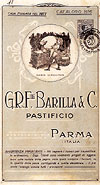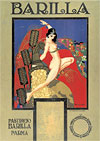 Interview
with Giancarlo Gonizzi Interview
with Giancarlo Gonizzi (G.G.) –
Person-in-charge of Barilla Historical Archives
– 26th February 2001 (updated 15th September
2004)
by Maria
Chiara Corazza (M.C.C.)
|
|
Enlarge text |
 |
 |
|
Reconstructing an archives
The archives today
Classifying a wide variety of records
The archives collects, preserves and communicates
Business culture organizations
G.G.: Barilla’s
business started in the 1800’s
with a bakery in Via Repubblica, in the very centre
of Parma In 1910 the business grew and moved outside
the city walls (that no longer exist) to where we
are now conducting this interview in Viale Barilla
(Barilla Boulevard). In this place the first
Barilla industrial plant was established,
made up of a pasta factory and a bake house, in
two different buildings. During the 1900’s,
the complex gradually enlarged until the end of
the thirties. In 1940 the Barilla family took over
and built up the whole area, which now belongs to
them.
 During the post-war years, the old buildings were
pulled down; during the fifties a new factory was
built and finally in 1999 almost all the existing
buildings were demolished to make room for famous
architect Renzo Piano’s project, a structure
which is open to the town, while retaining its distinct
original character. The project includes a hotel,
a Conference Centre, a big shopping mall with an
8 cinema multiplex and also the seat of the Barilla
Academy, with the classrooms for courses, and the
gastronomic library.
During the post-war years, the old buildings were
pulled down; during the fifties a new factory was
built and finally in 1999 almost all the existing
buildings were demolished to make room for famous
architect Renzo Piano’s project, a structure
which is open to the town, while retaining its distinct
original character. The project includes a hotel,
a Conference Centre, a big shopping mall with an
8 cinema multiplex and also the seat of the Barilla
Academy, with the classrooms for courses, and the
gastronomic library.
M.C.C.: When did the business
start to show interest into the company history
and subsequently, its archives ?
G.G.: Barilla began to think about
its own history in the very moment
that the company was about to be taken over. In
1970, due to a series of social and financial causes,
Gianni and Pietro Barilla sold
off their firm to the American multinational W
R Grace & Co.. The new factory (the
old one was on Viale Barilla) of Pedrignano,
located next to the Milan-Salerno Sole motorway
had been opened only two years before (1968).  The
debts for that new and ultramodern construction
were heavy, and since Gianni Barilla intended to
give up his part of the business, Pietro didn’t
have sufficient resources to buy out his brother’s
capital share. At that point, the firm was handed
over, but Pietro kept 1% of the shares and the right
of pre-emption, which allowed him to buy
back the firm in 1979.
When he came back, he promptly applied himself to
investments, product enhancement and the brand-new
Mulino Bianco line.
The
debts for that new and ultramodern construction
were heavy, and since Gianni Barilla intended to
give up his part of the business, Pietro didn’t
have sufficient resources to buy out his brother’s
capital share. At that point, the firm was handed
over, but Pietro kept 1% of the shares and the right
of pre-emption, which allowed him to buy
back the firm in 1979.
When he came back, he promptly applied himself to
investments, product enhancement and the brand-new
Mulino Bianco line.
At
some point, following requests from both inside
and outside the company, we realized that a firm
that had begun operating over a hundred years ago,
didn’t have any formally written history.
Journalists were asking for information but the
records about the firm’s history no longer
existed, because when Grace took over the business,
the main core of the former business
archives had been destroyed or
lost. Of course this wasn’t the first
priority for Grace who was more concerned with building
for the future. Anyway, in the mid-80’s, the
need arose for recovering a part of Barilla’s
historical patrimony. In 1987 then,
on the initiative of the chairman office, the Historical
Archives Project started. The project aimed
to recover this patrimony through the documents
inside the firm, scattered among the offices, but
also through the copying of those materials in third
party archives such as suppliers, advertising agencies
and public or private archives.
So, that’s how the archives came into
being; in 1987 with about
sixty photographs recovered accidentally. Now the
Barilla Archives have over forty two thousand inventoried
documents.  In
1997 they were declared archives of remarkable
historical interest by the Soprintendenza
(bureau of cultural assets). Through careful and
detailed research and recovery (still ongoing),
some basic series have been reconstructed like advertising,
for example: press advertisements on daily newspapers,
magazines or billposting, but also broadcast advertising
on radio and television. Other series too have been
restored as well; for instance the launching of
new products. These particular characteristics of
the Barilla Archives, which I would call an «archives
of reconstruction», constitute their
configuration, but, at the same time, their limit.
In
1997 they were declared archives of remarkable
historical interest by the Soprintendenza
(bureau of cultural assets). Through careful and
detailed research and recovery (still ongoing),
some basic series have been reconstructed like advertising,
for example: press advertisements on daily newspapers,
magazines or billposting, but also broadcast advertising
on radio and television. Other series too have been
restored as well; for instance the launching of
new products. These particular characteristics of
the Barilla Archives, which I would call an «archives
of reconstruction», constitute their
configuration, but, at the same time, their limit.
In our case, we had to recover single documents,
strips and other bits and pieces. Then it was a
matter of coming up with a classifying configuration
and logic for reasons of order,
convenience and, of course, preservation. So we
can find the archives structured in an extremely
handy and practical way, even for those who enter
for the first time, simply because it resembles
more the classification of a library rather than
of a traditional archives. This implies certain
limits, but also convenience.
Of course, where single record groups with their
inner arrangement were found, we chose to keep them
as they were, obviously using the normal standards
of arrangement and shelving, while trying to respect
their former internal configuration.
The use of illustrations kindly granted by Archivio storico Barilla © Barilla G. & R. F.lli Spa
